
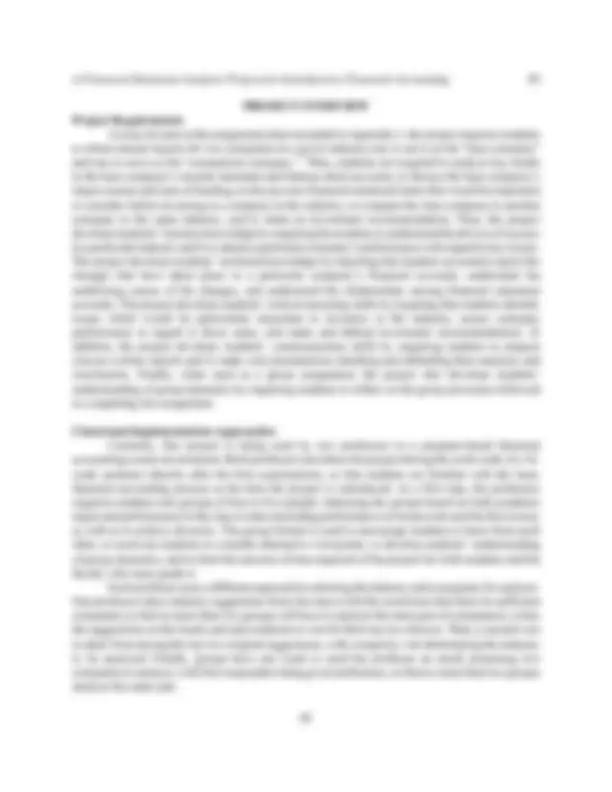
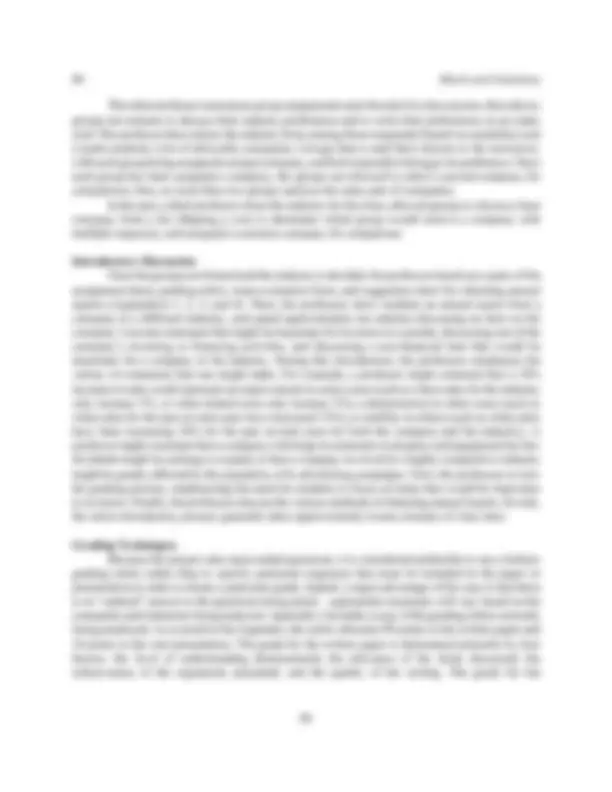
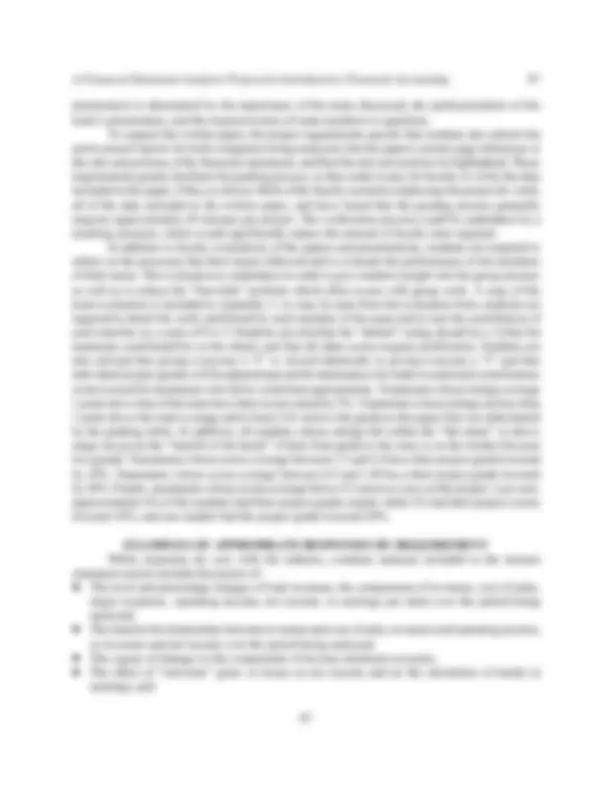
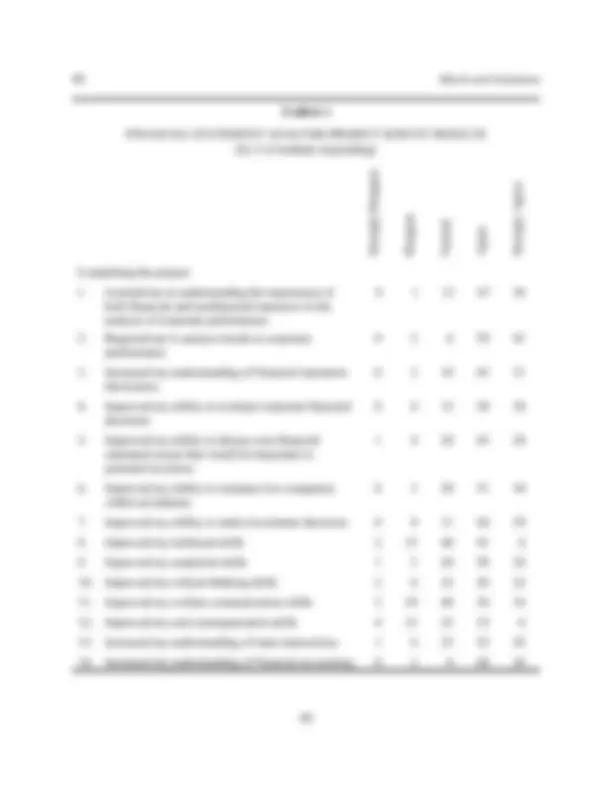
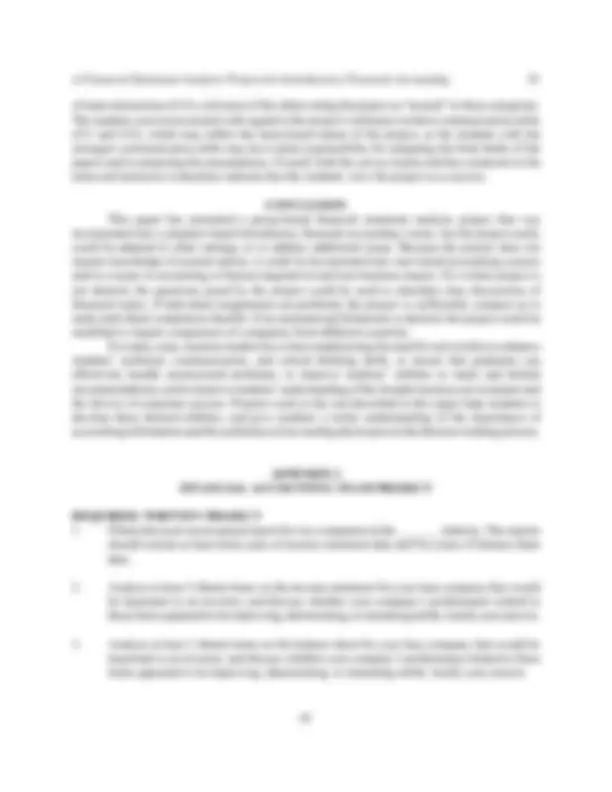
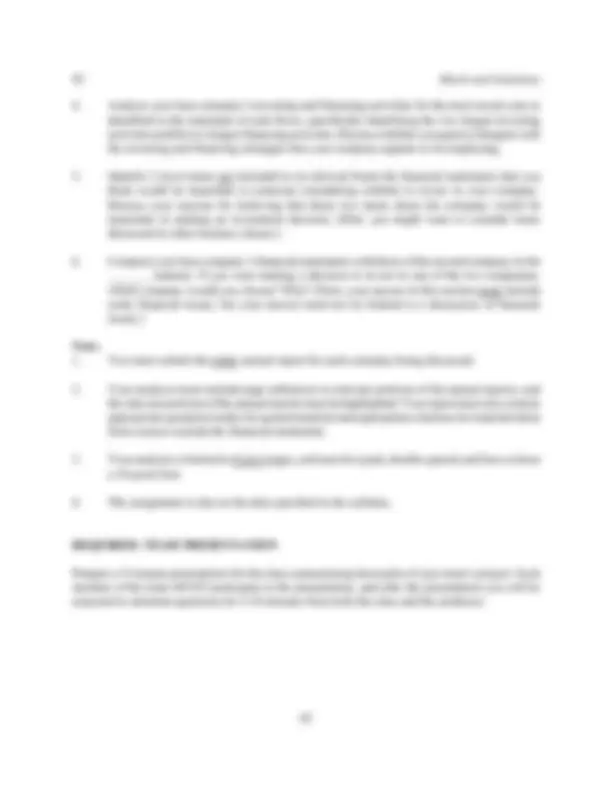
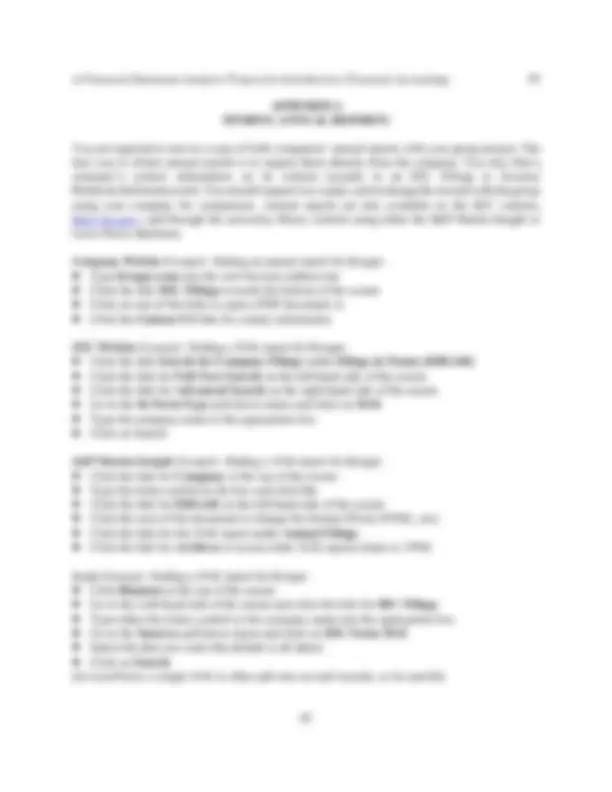
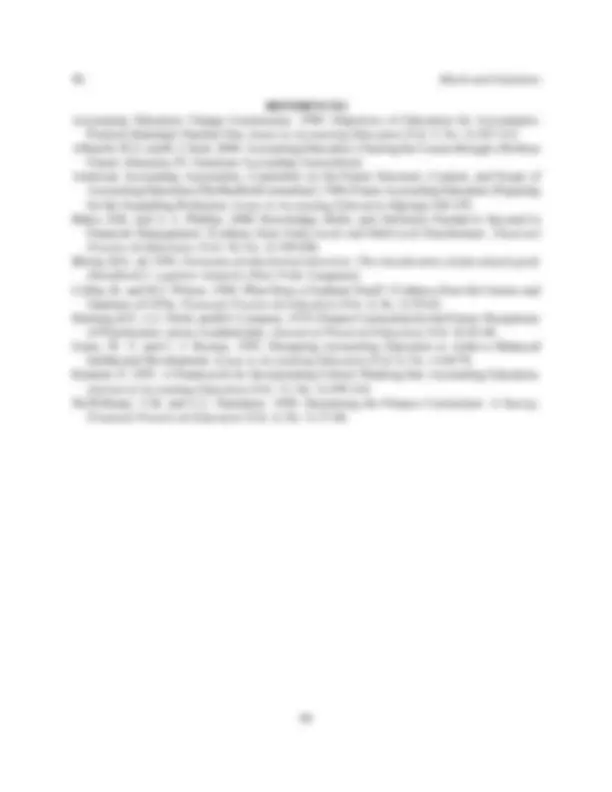


Study with the several resources on Docsity

Earn points by helping other students or get them with a premium plan


Prepare for your exams
Study with the several resources on Docsity

Earn points to download
Earn points by helping other students or get them with a premium plan
Community
Ask the community for help and clear up your study doubts
Discover the best universities in your country according to Docsity users
Free resources
Download our free guides on studying techniques, anxiety management strategies, and thesis advice from Docsity tutors
A financial statement analysis project used in introductory accounting courses to develop students' technical, analytical, critical thinking, and communication skills. The project requires students to analyze trends in corporate performance, evaluate financial decisions, discuss non-financial items, compare companies within an industry, and make investment recommendations. The project has been successful in increasing students' understanding of financial accounting and financial statement disclosures, improving their ability to evaluate corporate financial decisions, and enhancing their communication skills.
Typology: Study Guides, Projects, Research
1 / 14

This page cannot be seen from the preview
Don't miss anything!









Global Perspectives on Accounting Education Volume 6, 2009, 83-
Marilyn B. Misch Business Administration Division Pepperdine University Malibu, California USA
Carolyn A. Galantine Business Administration Division Pepperdine University Malibu, California USA
This paper describes a financial statement analysis project useful in both preparer- based and user-based introductory courses in financial accounting. The project requires students to analyze trends in corporate performance, to evaluate corporate financial decisions, to discuss non-financial statement issues that would be important to potential investors, to compare two companies within an industry, and to make investment recommendations. The project’s requirements are completely detailed on a single page, and the project is applicable to companies in any industry. The project requires only limited introduction in the classroom, is easily adaptable to reflect instructor preferences, and may be used as either an individual or a group assignment. This paper includes the complete project requirement sheet, a grading rubric, a team evaluation form, examples of items that students might be expected to address in answering the questions posed, comments on the results of employing the project, and additional suggestions for implementation.
Key words: Financial statement analysis, financial decision making, introductory accounting project, accounting case
84 Misch and Galantine
INTRODUCTION
his paper presents a financial statement analysis project that has been used for more than a decade in a university’s introductory financial accounting courses. The primary goal of the project is to develop students’ technical, analytical, critical thinking and communication skills by requiring students to: analyze key aspects of a company’s financial disclosures; evaluate a company’s financial decisions; discuss non-financial items that affect a company’s ability to be successful; compare one company to another in the same industry; and make and defend investment recommendations. In addition, when used as a group assignment, the project also develops students’ understanding of group dynamics by requiring students to reflect on the group processes followed in completing the assignment. The university in which the project has been employed is a small, private, liberal arts university, which has approximately 750 accounting, business, and international business majors, all of whom are required to take the introductory course in financial accounting. The course is most students’ first or second course in business and generally is taken during students’ freshman or sophomore years. Approximately 250 students are enrolled in the course each year, in sections of 25 to 30 students. The project is currently employed to strengthen the investor-orientation (user) dimension of courses that are primarily preparer-based, but the project does not require knowledge of journal entries and easily could be incorporated into user-based principles of accounting courses as well. Along with emphasizing the importance of accounting disclosures in decision-making, the project meets the calls from both academics and practitioners in various business fields for undergraduate programs to develop students’ communication skills and students’ abilities to understand, analyze, and evaluate financial disclosures (Demong et al., 1979; American Accounting Association, 1986; Geary and Rooney, 1993; Collier and Wilson, 1994; Albrecht and Sack, 2000; Baker and Phillips, 2000). Many commercially-available financial statement analysis projects are in books exceeding 100 pages, and primarily require students to obtain descriptive facts about companies and industries (many of which will not apply to a particular company being analyzed) and to calculate ratios. Such projects are open to the common criticisms faced by accounting and finance programs of focusing too much attention on rule application and highly-structured problem solving, and failing to develop what Bloom’s Taxonomy (1956) refers to as the higher-order skills of analysis, synthesis, and evaluation (Accounting Education Change Commission, 1990; Geary and Rooney, 1993; McWilliams and Pantalene, 1994: Albrecht and Sack, 2000). The project in this paper, on the other hand, is much more in keeping with the recommendations of authors such as Kimmel (1995), who call for using cases which do not have unique solutions and which require students to formulate recommendations on the basis of incomplete information. The project included here has only six requirements, which are completely detailed on a single page. Yet, while the requirements provide a systematic framework for completion, they also are open-ended, inducing students to create analyses tailored to the particular circumstances encountered by the specific companies and specific industries being analyzed at a particular point in time.
86 Misch and Galantine
The other professor announces group assignments near the end of a class session, then allows groups ten minutes to discuss their industry preferences and to write their preferences on an index card. The professor then selects the industry from among those requested (based on suitability) and e-mails students a list of allowable companies. Groups then e-mail their choices to the instructor, with each group being assigned a unique company, and first responders being given preference. Once each group has been assigned a company, the groups are allowed to select a second company for comparison; thus, no more than two groups analyze the same pair of companies. In the past, a third professor chose the industry for the class, allowed groups to choose a base company from a list (flipping a coin to determine which group would receive a company with multiple requests), and assigned a common company for comparison.
Introductory Discussion Once the groups are formed and the industry is decided, the professors hand out copies of the assignment sheet, grading rubric, team evaluation form, and suggestion sheet for obtaining annual reports (Appendices 1, 2, 3, and 4). Then, the professors show students an annual report from a company in a different industry, and spend approximately ten minutes discussing an item on the company’s income statement that might be important for investors to consider, discussing one of the company’s investing or financing activities, and discussing a non-financial item that would be important for a company in the industry. During this introduction, the professors emphasize the variety of comments that one might make. For example, a professor might comment that a 10% increase in sales could represent an improvement in some cases (such as when sales for the industry only increase 5%, or when related costs only increase 3%), a deterioration in other cases (such as when sales for the past several years have increased 15%), or stability in others (such as when sales have been increasing 10% for the past several years for both the company and the industry). A professor might comment that a company with large investments in property and equipment but few dividends might be seeking to expand, or that a company involved in a highly-competitive industry might be greatly affected by the popularity of its advertising campaigns. Next, the professors review the grading process, emphasizing the need for students to focus on items that would be important to investors. Finally, the professors discuss the various methods of obtaining annual reports. In total, the entire introductory process generally takes approximately twenty minutes of class time.
Grading Techniques Because the project asks open-ended questions, it is considered preferable to use a holistic grading rubric rather than to specify particular responses that must be included in the paper or presentation in order to obtain a particular grade. Indeed, a major advantage of the case is that there is no “optimal” answer to the questions being asked—appropriate responses will vary based on the companies and industries being analyzed. Appendix 2 includes a copy of the grading rubric currently being employed. As is noted in the Appendix, the rubric allocates 90 points to the written paper and 10 points to the oral presentation. The grade for the written paper is determined primarily by four factors: the level of understanding demonstrated; the relevance of the items discussed; the cohesiveness of the arguments presented; and the quality of the writing. The grade for the
A Financial Statement Analysis Project for Introductory Financial Accounting 87
presentation is determined by the importance of the items discussed, the professionalism of the team’s presentation, and the responsiveness of team members to questions. To support the written paper, the project requirements specify that students also submit the entire annual reports for both companies being analyzed, that the papers contain page references to the relevant portions of the financial statements, and that the relevant portions be highlighted. These requirements greatly facilitate the grading process, as they make it easy for faculty to verify the data included in the paper, if they so choose. Both of the faculty currently employing the project do verify all of the data included in the written paper, and have found that the grading process generally requires approximately 45 minutes per project. The verification process could be undertaken by a teaching assistant, which would significantly reduce the amount of faculty time required. In addition to faculty evaluations of the papers and presentations, students are required to reflect on the processes that their teams followed and to evaluate the performance of the members of their teams. This evaluation is undertaken in order to give students insight into the group process as well as to reduce the “free-rider” problem which often occurs with group work. A copy of the team evaluation is included in Appendix 3. As may be seen from the evaluation form, students are required to detail the work performed by each member of the team and to rate the contribution of each member on a scale of 0 to 5. Students are told that the “default” rating should be a 3 (that the teammate contributed his or her share), and that all other scores require justification. Students are also advised that giving everyone a “5” is viewed identically to giving everyone a “3” and that individual project grades will be adjusted upward for teammates who make exceptional contributions or downward for teammates who fail to contribute appropriately. Teammates whose ratings average 1 point above that of the team have their scores raised by 5%. Teammates whose ratings are less than 1 point above the team average and at least 2.41 receive the grade on the paper that was determined by the grading rubric. In addition, all students whose ratings fall within the “fair share” or above range are given the “benefit of the doubt” if their final grade in the class is on the border between two grades. Teammates whose scores average between 1.5 and 2.4 have their project grade lowered by 10%. Teammates whose scores average between 0.5 and 1.49 have their project grade lowered by 20%. Finally, teammates whose scores average below 0.5 receive a zero on the project. Last year, approximately 6% of the students had their project grades raised, while 2% had their project scores lowered 10%, and one student had the project grade lowered 20%.
While responses do vary with the industry, common analyses included in the income statement section include discussion of: ! The level and percentage changes of total revenues, the components of revenues, cost of sales, major expenses, operating income, net income, or earnings per share over the period being analyzed; ! The trend in the relationship between revenues and cost of sales, revenues and operating income, or revenues and net income over the period being analyzed; ! The causes of changes in the components of income statement accounts; ! The effect of “one-time” gains or losses on net income and on the calculation of trends in earnings; and
A Financial Statement Analysis Project for Introductory Financial Accounting 89
! The relative performance of the two companies’ equity shares on the stock market; ! The relative rankings of the companies on customer satisfaction surveys and in market share; ! The relative quality and stability of company management; and ! The importance of determining whether an investor is looking for short-term returns or long-term growth.
At the beginning of the most recent semester completed, the professors in each of the introductory financial accounting classes gave students a survey to determine how many of them had seen an annual report prior to enrolling in financial accounting. Based on that survey, fewer than 20% of the students had ever looked at an annual report prior to entering the class, and only 25% could give even one detailed answer when asked about financial items that would be important to investors. Despite the students’ initial lack of familiarity with financial disclosures, 90% of the teams, in their final reports, demonstrated moderate or better understanding of key financial disclosures, the relationships among accounts, and the drivers of success for the industries being reviewed. In addition, during the oral presentations at the end of the term, students addressed the vast majority of the items presented above in the “examples of appropriate responses” discussion. Also, because students understand from the beginning that team members will be required to give detailed descriptions of each team member’s contribution and to rate the contributions numerically (and that the ratings have a potential impact on grades), free riding appears to be less of an issue than might otherwise be expected in a group project. With regard to student perceptions of the project, over 90% of the students commented favorably on the project in the team evaluation forms in the most recent semester, and in the university-mandated anonymous teacher evaluations given at the end of class each term, approximately one-third of the class typically identifies the project as being “the best aspect of the class.” In addition, at the end of the most recent term, an anonymous survey was administered to directly seek student perceptions of the project. The results of the survey are summarized below in Table 1. As Table 1 indicates, the large majority of students “agreed” or “strongly agreed” that the project increased their understanding of both financial accounting (#14) and the importance of understanding both financial and nonfinancial measures when evaluating corporate performance (#1). A similar majority “agreed” or “strongly agreed” that the project required them to analyze trends in corporate performance (#2), increased their understanding of financial statement disclosures (#3), increased their abilities to evaluate corporate financial decisions (#4) and increased their abilities to make investment decisions (#7). While many students “agreed” that the project improved their technical skills (#8), 41% of students rated the project as “neutral” in this area. This result is somewhat surprising given the strong ratings regarding the project’s influence on students’ understanding of financial accounting and financial statement disclosures, and may reflect a lack of clarity inherent in the general term “technical skills.” A substantial majority of the students “agreed” or “strongly agreed” that the project improved their ability to discuss non-financial statement items important to investors (#5), improved their ability to compare companies within an industry (#6), increased their analytical and critical thinking skills (#9 and #10), and increased their understanding
90 Misch and Galantine
(by # of students responding)
Strongly DisagreeDisagreeNeutralAgree Strongly Agree Completing the project:
92 Misch and Galantine
Note:
Prepare a 15 minute presentation for the class summarizing the results of your team’s project. Each member of the team MUST participate in the presentation, and after the presentation you will be expected to entertain questions for 5-10 minutes from both the class and the professor.
A Financial Statement Analysis Project for Introductory Financial Accounting 93
APPENDIX 2 GRADING RUBRIC
The written projects are worth 90 points and will be graded in two phases:
! First, the projects will be reviewed for compliance with the basic requirements and for composition. Any projects submitted without the entire annual reports for both companies being discussed, without appropriate page references to the relevant portions of the annual reports, without appropriate highlighting of the relevant portions of the annual reports, without appropriate citations for material taken from sources outside the annual reports, and/or with excessive composition errors will have to be resubmitted. Any papers requiring resubmission for the above reasons will be docked a minimum of 27.5 points out of 90.
! Second, the papers will be reviewed for content and will be graded using the following rubric " 81-90 points: The paper is well written, free of grammatical and other writing errors, and well organized. The report addresses each of the issues specified in the requirements, uses appropriate examples to illustrate concepts discussed, and integrates the annual report data with the narrative. The report focuses on important items, demonstrates a thorough understanding of the relationships among financial statement data, and is cohesive. " 72-80.5 points: The paper generally is well written but may have minor grammatical or other writing errors or lack smooth transitions. The report addresses the issues specified in the requirements, demonstrates understanding, and focuses mainly on important items, but does not fully synthesize the material being discussed, and/or does not integrate the annual report data with the narrative. " 67.5-71.5 points: The paper does not have excessive grammatical or other writing errors. The report addresses the issues specified in the requirements, but demonstrates only moderate understanding, and/or lacks integration. " 63-66.5 points. The paper does not have excessive grammatical or other writing errors. The report addresses the issues specified in the requirements, but demonstrates only minimal understanding of one or more of the issues. " 54-62.5 points. The paper is acceptable after initially requiring resubmission due to failure to comply with the basic requirements, excessive composition errors, or failure to demonstrate understanding of two or more of the issues required to be discussed. " 0 points. The paper fails to meet the basic requirements, has excessive composition errors, and/or fails to demonstrate understanding of two or more of the issues required to be discussed after a first resubmission.
The oral presentations are worth 10 points, with 5 points allocated to the importance and relevance of the matters discussed; 3 points allocated to the professionalism of the presentation; and 2 points allocated to the team’s responsiveness to questions. Every member of the team is required to participate in the presentation.
A Financial Statement Analysis Project for Introductory Financial Accounting 95
APPENDIX 4 FINDING ANNUAL REPORTS
You are required to turn in a copy of both companies’ annual reports with your group project. The best way to obtain annual reports is to request them directly from the company. You may find a company’s contact information on its website (usually in an SEC Filings or Investor Relations/Information tab). You should request two copies, and exchange the second with the group using your company for comparison. Annual reports are also available on the SEC website, http://sec.gov/, and through the university library website using either the S&P Market Insight or Lexis-Nexis databases.
Company Website Example: finding an annual report for Kroger: ! Type Kroger.com into the web browser address bar ! Click the link SEC Filings towards the bottom of the screen ! Click on one of the links to open a PDF document or ! Click the Contact US link for contact information
SEC Website Example: finding a 10-K report for Kroger: ! Click the link Search for Company Filings under Filings & Forms (EDGAR) ! Click the link for Full Text Search on the left-hand side of the screen ! Click the link for Advanced Search on the right-hand side of the screen ! Go to the In Form Type pull-down menu and click on 10-K ! Type the company name in the appropriate box ! Click on Search
S&P Market Insight Example: finding a 10-K report for Kroger: ! Click the link for Company at the top of the screen ! Type the ticker symbol in the box and click Go ! Click the link for EDGAR on the left-hand side of the screen ! Click the icon of the document to change the format (Word, HTML, etc) ! Click the link for the 10-K report under Annual Filings ! Click the link for Archives to access older 10-K reports (back to 1994)
Lexis Example: finding a 10-K report for Kroger: ! Click Business at the top of the screen ! Go to the Left-hand side of the screen and click the link for SEC Filings ! Type either the ticker symbol or the company name into the appropriate box ! Go to the Sources pull-down menu and click on SEC Form 10-K ! Select the date you want (the default is all dates) ! Click on Search (In LexisNexis, a single 10-K is often split into several records, so be careful)
96 Misch and Galantine
REFERENCES Accounting Education Change Commission. 1990. Objectives of Education for Accountants: Position Statement Number One. Issues in Accounting Education (Vol. 5, No. 2) 307-312. Albrecht, W.S. and R. J. Sack. 2000. Accounting Education: Charting the Course through a Perilous Future. (Sarasota, Fl: American Accounting Association). American Accounting Association, Committee on the Future Structure, Content, and Scope of Accounting Education (The Bedford Committee). 1986. Future Accounting Education: Preparing for the Expanding Profession. Issues in Accounting Education (Spring) 168-195. Baker, H.K. and A. L. Phillips. 2000. Knowledge, Skills, and Attributes Needed to Succeed in Financial Management: Evidence from Entry-Level and Mid-Level Practitioners. Financial Practice & Education, (Vol. 10, No. 2) 189-200. Bloom, B.S., ed. 1956. Taxonomy of educational objectives: The classification of educational goals (Handbook I: cognitive domain ). (New York: Longman). Collier, B. and M.J. Wilson. 1994. What Does a Graduate Need?: Evidence from the Careers and Opinions of CFOs. Financial Practice & Education (Vol. 4, No. 2) 59-65. Demong, R.F., L.C. Pettit, and B.J. Campsey. 1979. Finance Curriculum for the Future: Perceptions of Practitioners versus Academicians. Journal of Financial Education (Vol. 8) 45-48. Geary, W. T. and C. J. Rooney. 1993. Designing Accounting Education to Achieve Balanced Intellectual Development. Issues in Accounting Education (Vol. 8, No. 1) 60-70. Kimmel, P. 1995. A Framework for Incorporating Critical Thinking Into Accounting Education. Journal of Accounting Education (Vol. 13, No. 3) 299-318. McWilliams, V.B. and C.C. Pantalene. 1994. Structuring the Finance Curriculum: A Survey. Financial Practice & Education (Vol. 4, No. 1) 37-46.